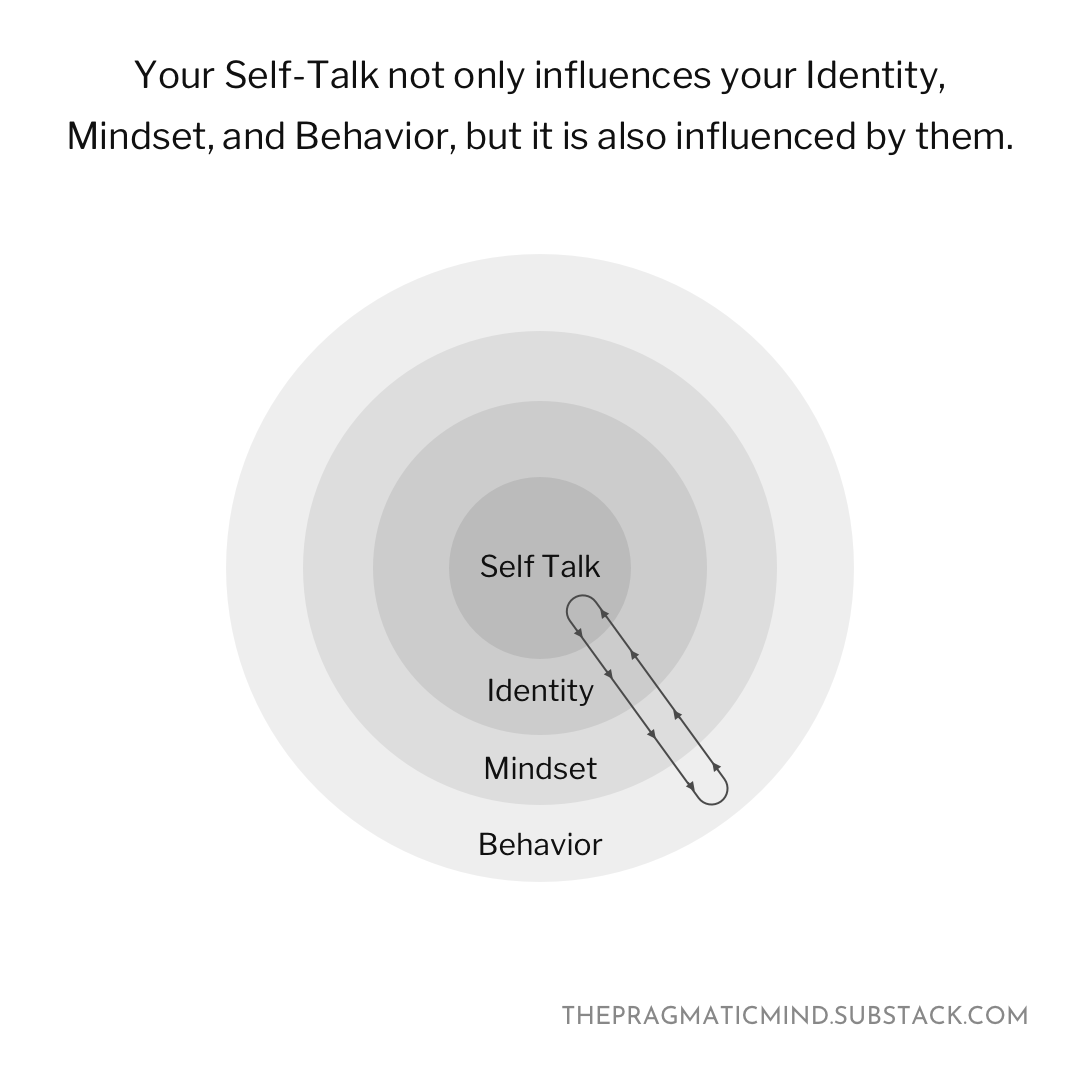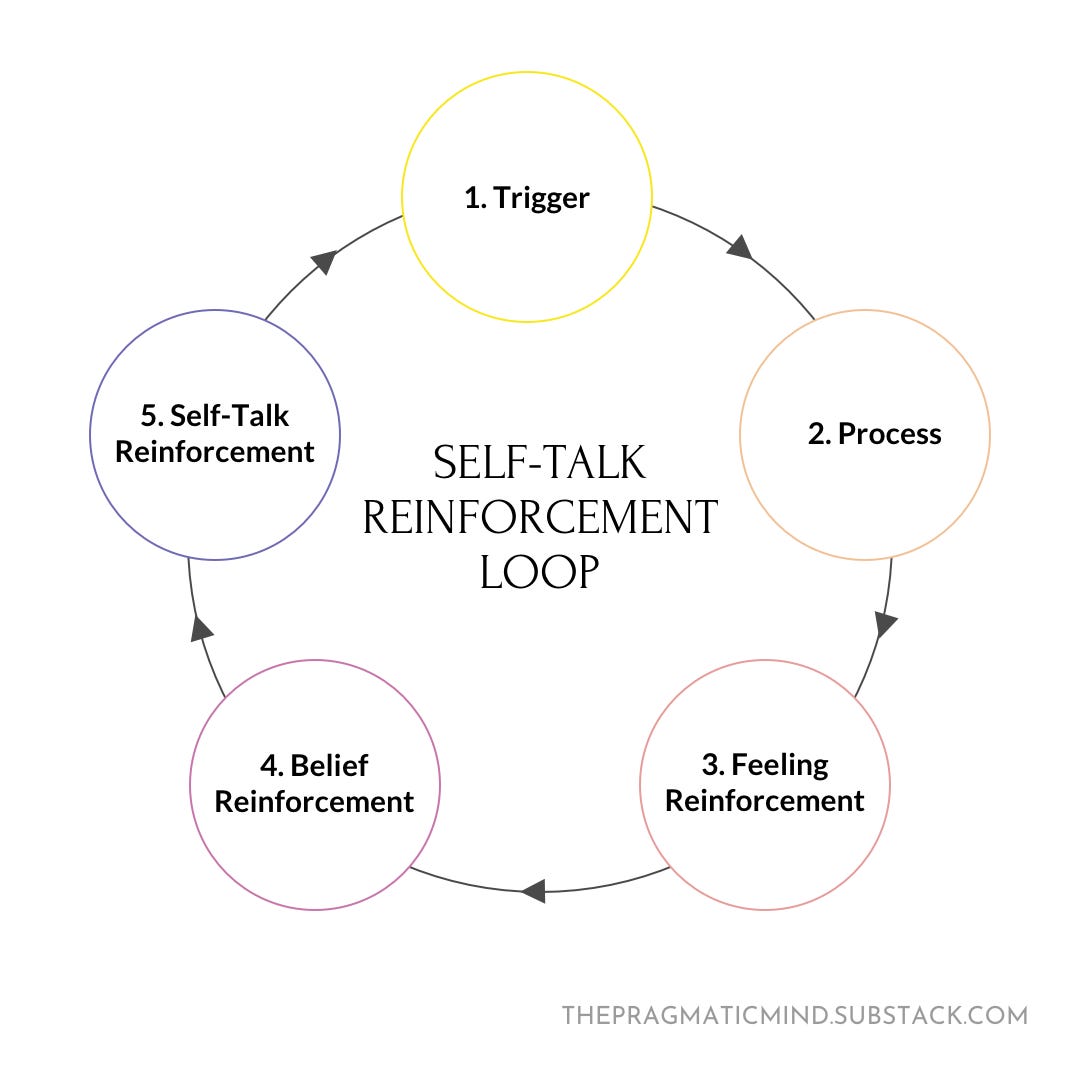It's afternoon. I'm standing alone on the balcony of our Second-floor apartment, waiting for a school bus to appear in the distant playground. My elder sister would be on that bus returning from school, which I'm too young to join. I'm not tall enough yet. So, I squeeze my head into the gap in the balcony grill to sneak a peek with just my right eye. Then, a bus appears in the distance. I still vividly remember saying to no one, "That's not her bus. She will be on the next one." It is the earliest memory I have of talking to myself.
When I look back, that moment, though simple, is profound. It's pretty easy to realize that even as a child, I was engaging in something we all do every single day: Self Talk. We might not consciously notice, but this internal dialogue shapes how we see ourselves and the world around us. It's pretty much like using Siri or Google Assistant. The only difference is that it's inside of us, in our heads, and it knows us better than anyone else could ever.
Since Artificial Intelligence (AI) has begun to dominate our collective psyche, here's a thought: We are all just AI, with the only difference being we are sentient. Much like a theoretical sentient AI, we learn and adapt based on our environment. Now, the environment is programming us, sort of, indirectly. Our Self Talk is the internal manifestation of this programming. It is saying this is what you can expect, that is not what you can expect, this is possible, that is not possible.. In a way, our Self Talk draws a boundary around our expectations.
As we age, the boundary that our Self-talk creates around our expectations gets reinforced repeatedly. So, as adults, our expectations of what's possible become more and more confined. We start throttling our potential by refusing to ask, "What if?" And we also lose sight of what's important to us.
So, in a way, this internal dialogue—this self-talk—shapes our reality. It is core to our Being.
SELF-TALK (The Protagonist of the Story)
Self-talk is at the core of our Being.
We talk to ourselves all the time. Our Self-Talk could be out loud, or it could be in the form of thoughts. It could also be in the form of feelings that we haven't yet given words to. Ever since we are born, we have been storing, analyzing, judging, and evaluating everything that goes on around us, about us. Most of the time, Self-Talk occurs just below our consciousness. We are not even aware of it.
As you might have noticed by now, your mind is a thought machine that churns out thoughts non-stop. Whenever you find something fresh, the mind associates it with something known. This process of connecting the new with the old acts as a reinforcement of our thinking patterns. That is why we have the saying, "You can't teach an old dog new tricks." Our Self-Talk plays a crucial role in this.
Self-talk helps us make sense of our Identity, Beliefs, Mindsets, and Behavior. It is at the core of our Being. It shapes and influences how we see ourselves, what beliefs we have and don't have, and what kind of mindset we possess. Ultimately, our Self-Talk determines how we behave in the long run.
Imagine peeling an onion. The outer layer is your behavior, the next inner layer is your Mindset, and then comes your Identity, and, at the core of that onion analogy, is your Self-Talk. Now, the catch here is that it's not a one-way street. You might think that your Self-Talk directs your Identity, Mindset, and behavior. And you're not wrong in thinking that. But what's also true is how you behave intuitively, your Mindset, and the Identity you have created over the years influence your Self-Talk too.
At this point, an obvious question might pop into your head. If it's a two-way street, why is Self-Talk at the center and not just one of the cogs? The answer lies in how Self-Talk acts as the first filter through which we process everything we experience.
Think of it like this: every experience you go through—whether it’s success, failure, or something as mundane as choosing what to eat—is immediately colored by your Self-Talk. Before you even consciously react or decide, you’ve already had an internal dialogue. The Self-Talk is the narrator of your story, constantly interpreting what’s happening. The other elements—your Identity, Mindset, and Behavior—are shaped by the stories and narratives that your self-talk creates.
Self-Talk Drives Interpretation
Even when you act instinctively, a whisper of internal dialogue interprets that action. For instance, after you make a mistake, self-talk either softens the blow with “It’s okay; everyone makes mistakes” or sharpens it with “How could you mess that up again?” These reactions aren’t just passive. Over time, they shape how you see yourself—your identity—and how you approach challenges—your Mindset.
It’s a Constant Feedback Loop
Yes, your Mindset and Identity also influence how you talk to yourself, but the Self-Talk runs the show, even if you aren’t aware of it. Imagine walking into a new social situation. If your Mindset is generally positive, your Self-Talk might say, “You’ve got this!” But if your behavior at that moment causes a slip-up, your Self-Talk might switch to doubt. That switch is powerful because now it’s feeding new data into your Identity and Mindset, reshaping them.
Self-Talk as the Core of Change
This is why self-talk is at the core of your Being. Changing it can shift everything else. While it interacts with your Behaviors, Mindset, and Identity, it is through self-talk that you can begin to change your entire outlook. Imagine it as the control center. When you consciously change your self-talk — like flipping a negative thought into a more positive one — you’re rewiring the narrative. You just need to start small—like changing the font on a document before you rewrite the whole thing.
How Self-Talk is Formed and Reinforced (Giving it the FoRC Treatment)
I have a confession to make. I hate producing word salads. Word salads might make you feel good for a moment but don't provide anything concrete or actionable in the long run. At the bare minimum, writing should deepen our understanding of a topic. So, to convince myself I'm not writing a word salad :), I'll use the FoRC Framework here. (I Introduced the FoRC Framework in the Psychology of Actions: Introduction article. You can click here to check it out.)
Self-Talk Formation Loop
Now, the Self-Talk shapes who we are, but how does it form? How does it dig its roots so deep into our identity? Here’s where the Formation Loop comes in. Let’s break it down - without jargon, just a simple process that’s easy to grasp.
Here's the 5-step Self-Talk Formation Loop:
1. Observe
It all starts with Observation. Something catches your attention—maybe it’s a comment someone made, a result of something you tried, or even a passing thought. You Observe that experience, and at that moment, your brain starts to analyze it. It is where the seeds of self-talk get planted.
2. Absorb
From observation, you move to Absorb. This is where your brain, like a sponge, takes in that observation and connects it with everything you’ve known beforehand. Think of it as making sense of something new by linking it to something old. It’s like your mind saying, “Hey, I’ve seen this before, and this is what I know about it.” This is why we often react to things based on past experiences without even realizing it.
3. Feel
Next comes the emotional layer—Feel. How you absorb something always has an emotional undertone, even if that undertone is subtle. Whether it’s excitement, fear, or even indifference, there’s a feeling attached to the experience. And this feeling starts guiding how we shape our self-talk. Now, here’s where things get interesting—this leads us to what I call -
4. Loosely Believe
It’s not a fully formed belief yet. It’s like a half-written script in your mind that says, “Maybe this is true, maybe it’s not.” It’s flexible and open to change, but it’s there, waiting to be reinforced or revised by what happens next. This loose belief will either dissolve or become a more solidified part of your identity.
5. Self-Talk Formation
Finally, we move to Formation of Self-Talk. Based on this loose belief and how you feel, your Self-Talk starts to form. At this point, your self-talk has already begun to drive your behavior, even in these early stages.
Now, you’re probably wondering, "If it's just a loose belief at this point, how does it become something I carry with me for years?" That’s where the Reinforcement Loop kicks in. Let’s dive into that next.
Self-Talk Reinforcement Loop
Once the loose belief is in place, it’s not set in stone yet, but it’s waiting to be reinforced. This is where the Reinforcement Loop comes in. It turns that loose belief into a more fixed part of your Self-Talk.
The 5 steps of the Reinforcement Loop:
1. Trigger
It starts with a Trigger. Something—an experience, a thought, or even a memory—activates that loose belief. This trigger could be as small as someone making a remark about you or as significant as a failure you’ve experienced.
2. Process
Now that the belief is triggered, you move into the Processing stage. Here’s where that loosely formed belief gets a bit more attention. Your mind processes the trigger through the lens of that belief. It might be something like, “See? I knew I couldn’t do this.” Or it could be more subtle: “Maybe this isn’t for me after all.” But at this stage, it’s still being worked out, and still open to change—though only slightly.
3. Feeling Reinforcement
This is where emotions come back into play, only now they’re stronger. Your initial feelings get amplified. If the belief is negative, the emotion intensifies, making the belief feel even more true. If the belief is positive, your confidence grows. Either way, these feelings start to lock the belief into place.
4. Belief Reinforcement
With every repeated experience, with every emotion that’s tied to this loose belief, the belief becomes less loose and more firm. It is where your self-talk solidifies, little by little, with each iteration. What started as a “maybe” now becomes a more definitive “I am,” “I’m not,” or “I can’t.”
5. Self-Talk Reinforcement
This is the last step, but it’s crucial because it keeps the loop running. Based on your now solidifying belief, the form of your Self-Talk starts getting reinforced. Your Self-Talk inturn reinforces that belief, whether it’s limiting or empowering. And just like that, you’ve completed the loop—ready for the next trigger to start it all over again.
Now, the beauty here is that if we repeat something over and over, the Mind will streamline the process. It will create shortcuts and make the responses automatic and effortless (Characteristics of System 1.) So, as the repetitions increase, we start skipping the steps in the Reinforcement Loop.
The Reinforcement Loop is just reduced to Trigger -> Feel -> React. Even in your Self-Talk you start to just react with same patterns.
Concluding Thoughts
Self-talk isn’t something that just happens to us. It’s a process. A loop. And now that we’ve broken down how it forms and gets reinforced, we can begin to understand how to change it. Because if self-talk is built through these loops, it can also be rebuilt. This is where the Laws of Change come in. We’ll get to that in the next article.
That’s all for this week. If you like this article, please share it. And, if you have not subscribed yet, please do and join me on this fascinating journey of intentional change.
Stay genuine! Stay authentic!
Nik Pathran
PS: I appreciate you reading. Thanks to the new subscribers!











